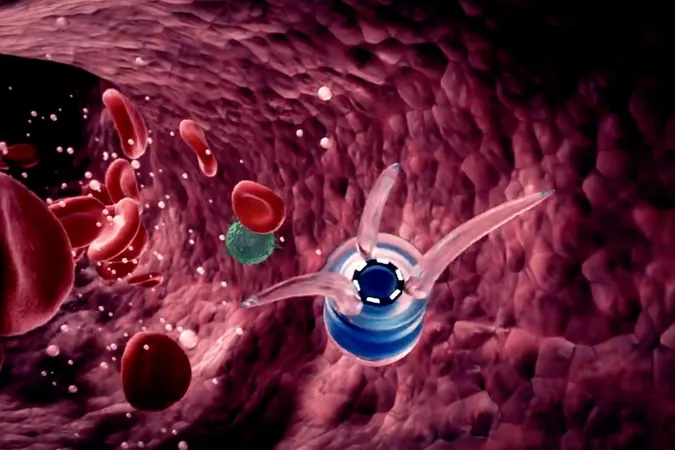
The Illusion of Nanotechnology: Dreams of Immortality and Fear of Oblivion
2025-09-02
Author: Nur
The Tech Fantasies of Yesterday Still Haunt Us Today
In the year 2000, tech visionary Bill Joy, co-founder of Sun Microsystems, raised alarms about the potentially perilous trajectory of technological advancement in a riveting Wired article titled 'Why the Future Doesn’t Need Us.' Joy cautioned that the relentless pursuit of certain technologies could inadvertently lead to our own extinction.
His concerns echo in today's tech landscape, as Silicon Valley moguls warn that artificial intelligence might surpass human intelligence, viewing us as obsolete. While Joy was apprehensive about 'sentient robots,' his foremost concern was nanotechnology—the manipulation of matter at an atomic scale, reminiscent of the size of molecules.
Nanotechnology: Utopia or Dystopia?
Bill Joy's trepidation was significantly influenced by K. Eric Drexler's book, 'Engines of Creation' (1986), which painted a picture of nanotechnology that promised incredible breakthroughs: cures for diseases, affordable solar energy, and even the resurrection of extinct species. These visions appeared to be a double-edged sword, offering utopian promises alongside nightmares of an apocalypse, like 'grey goo'—a hypothetical scenario where self-replicating nanobots completely dismantle the world at a molecular level.
Drexler's ideas ignited hopes of achieving immortality through merging human consciousness with machines, allegedly allowing us to upload our minds into a digital paradise. Futurist Ray Kurzweil speculated that by the 2020s, nanotechnology would empower us to create virtually anything from simple raw materials.
The Fantastical World of Oneiric Technologies
However, as of now, none of these tantalizing predictions have materialized. Not only have we seen no cures for cancer or a path to digital immortality, but we also have no terrifying grey goo to contend with. This is because Drexler's vision of nanotechnology was fundamentally flawed, creating a fantasy that serves more as a cultural landmark than a scientific foundation.
These 'oneiric technologies'—dream technologies—cloak desires and fears in scientific language, making them feel attainable even when they actually aren’t. From terraforming planets to cryonic preservation of brains, these vaporous dreams captivate the imagination of many tech billionaires.
The Enduring Influence of Drexler's Vision
Drexler conceived of nanotechnology after being inspired by a talk from physicist Richard Feynman in 1959, which envisioned manipulating atoms at an incredibly small scale. He published a seminal paper on the subject in 1981, and his vision attracted excitement and investment in the tech community despite its lack of foundational feasibility.
His assertion that molecular assemblers could replicate and build anything failed to consider the chaotic realities of molecular forces and stability. Critics, including esteemed chemists, dismissed his ideas as not scientifically sound.
Navigating the Mirage of the Future
Today, while legitimate advancements in nanotechnology are numerous, they differ radically from Drexler's fantastical claims. Real science has produced applications like quantum dots and DNA origami, while the notion of magical nanotechnology as originally proposed remains dormant.
The Foresight Institute, founded by Drexler, now supports actual scientific work unswervingly rooted in feasible chemistry rather than ethereal fantasies. Yet the legacy of oneiric technologies continues to cast shadows over modern pursuits.
Lessons Learned: Reality vs. Fantasy in Technology
The cautionary tale of Drexler's nanotechnology extends into the contemporary discussions around AI. Voices like Google’s Eric Schmidt project radical timelines for achieving superintelligent systems, entrancing many into a narrative filled with extravagance.
But we must not be seduced by these myths of oneiric technologies. Instead, we should focus on practical issues—climate change, equity, and societal instability—rather than being lured into a world of unattainable dreams. It’s time to engage critically with technology and ensure we prioritize present-day realities over fantastical visions.




 Brasil (PT)
Brasil (PT)
 Canada (EN)
Canada (EN)
 Chile (ES)
Chile (ES)
 Česko (CS)
Česko (CS)
 대한민국 (KO)
대한민국 (KO)
 España (ES)
España (ES)
 France (FR)
France (FR)
 Hong Kong (EN)
Hong Kong (EN)
 Italia (IT)
Italia (IT)
 日本 (JA)
日本 (JA)
 Magyarország (HU)
Magyarország (HU)
 Norge (NO)
Norge (NO)
 Polska (PL)
Polska (PL)
 Schweiz (DE)
Schweiz (DE)
 Singapore (EN)
Singapore (EN)
 Sverige (SV)
Sverige (SV)
 Suomi (FI)
Suomi (FI)
 Türkiye (TR)
Türkiye (TR)
 الإمارات العربية المتحدة (AR)
الإمارات العربية المتحدة (AR)